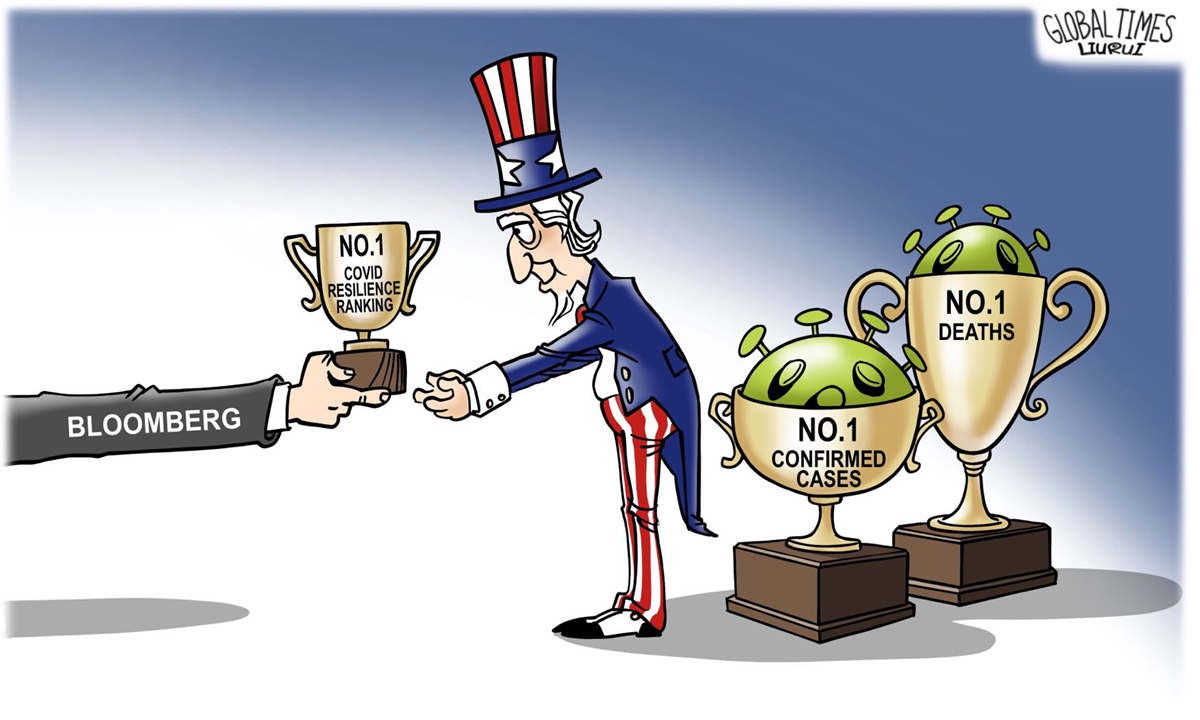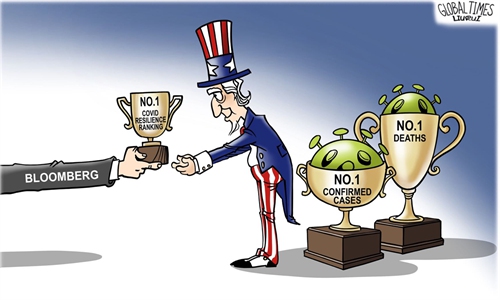
Cartoon: Liu Rui/GT
The recent COVID Resilience Ranking released by Bloomberg has aroused widespread controversy. In its ranking, Bloomberg takes into account "reopening progress" as a key factor in gauging the resilience of different countries and regions in the fight against coronavirus. However, such an evaluation system does not take into account the differences of epidemic prevention modes in different countries, and there are loopholes in the scientificity and strictness in setting of indicators. It is hard to believe that the US is one of the world's top anti-epidemic countries, especially since more than 34 million COVID-19 cases have been confirmed and more than 609,000 people have died as a result of the virus in the US.
In fact, the spread of infectious diseases is often closely linked to geographical factors and influenced by different population density, spatial proximity, political and cultural presence. The international community at the moment has basically two anti-epidemic models. The first one is the approach adopted by many Asian countries represented by China and Singapore - combining quarantine and vaccination. This measure is adopted for humanitarian reasons as well as for the quick recovery of the domestic economy.
On the other hand, countries like the UK, the US, and Australia hope to turn COVID-19 to simply a kind of flu by increasing vaccination rates. But it would be unfair to evaluate these countries' battle against the coronavirus based on mainstream Western mind-set, without taking into account their current epidemic situation and public opinion of these countries.
In the Bloomberg ranking, its sub-indexes lack representativeness and its data is controversial. It is also necessary to verify if its data source is legitimate and whether the indicators were developed through public evaluation by epidemic prevention experts during the entire evaluation process.
Some indicators are underrepresented. More direct and effective indicators should be provided as a result of epidemic prevention and control.
For instance, in the first five months of 2021, China's total imports and exports expanded 28.2 percent year on year to reach 14.76 trillion yuan ($2.31 trillion).
The rationality of some index data, on the other hand is relatively one-sided. Using only the proportion of vaccinations as an indicator is not rigorous, which failed to take into account the impact that the public trust will have on the vaccination and the normalization of epidemic prevention. So far, more than 3.62 billion shots are given globally. China received over 1.44 billion doses, compared to only 338 million in the US. In terms of the total number of vaccinations administered, China is much higher than the US. Second, the Chinese public's acceptance of vaccines is at a high level, in sharp contrast to the prevalence of "vaccine skepticism" in some countries. The improvement of scientific literacy of Chinese people is conducive to the continuous promotion of COVID-19 vaccine.
The ranking also gives us some inspiration. First of all, China should take the initiative to make its voice heard on major events in the field of international public opinion, raise views and provide index system representing its own perspective, and master the international discourse power.
The construction of indicators requires comprehensive and careful consideration to avoid similar flaws that will damage the fairness of the list.
The fundamental significance of ranking countries' anti-epidemic capacity is to provide advanced examples and effective reference solutions for other countries. Therefore, in the process of creating such indexes, domestic academic institutions and media should strengthen cooperation, and scholars should provide more scientific and rigorous evaluation and measurement standards from a professional perspective. Open data, clear indicators, and reasonable aspects are used in a scientific assessment of the global pandemic, as well as the ability to welcome open peer review.
The author is a professor at School of Journalism and Communication, Tsinghua University. opinion@globaltimes.com.cn



